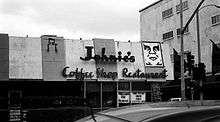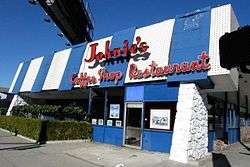Johnie's Coffee Shop
| Johnie's Coffee Shop | |
|---|---|
|
Johnie's Coffee Shop, 2007. | |
| Location |
6101 Wilshire Boulevard Los Angeles, California United States |
| Coordinates | 34°03′48″N 118°21′42″W / 34.063288°N 118.361603°WCoordinates: 34°03′48″N 118°21′42″W / 34.063288°N 118.361603°W |
| Built | 1956 |
| Architect | Armét & Davis |
| Architectural style(s) | Googie Style |
| Official name: Johnie's Coffee Shop Restaurant | |
| Designated | November 27, 2013 |
| Reference no. | 1045 |
Johnie's Coffee Shop is a former coffee shop and well known example of Googie architecture located on the corner of Wilshire Boulevard and Fairfax Avenue in Los Angeles, California.[1] Architects Louis Armét and Eldon Davis of Armét & Davis designed the building, contributing to their reputation as the premier designers of Space Age or Googie coffee shops—including the landmark Pann's coffee shop in Ladera Heights, Norms Restaurant on La Cienega Boulevard, and several Bob's Big Boy restaurants.[1]
History
Johnie's opened in 1956 as Romeo's Times Square. Romeo's was in business a few years, becoming Ram's in the early 1960s, and Johnie's shortly thereafter.[1]
"Johnie's" is spelled in massive neon lights and flashing incandescent lightbulbs on the building's striped roof. The roof sits on rock columns, sloping down toward the back of the restaurant, ending in a sharp decline that gives the illusion of movement like a spaceship ready to take off. Alan Hess, author of two books on Googie architecture, said, "Johnie's, and the style it represents, tells us as much about that period in L.A. history as the bungalows of Pasadena told us about the 1900s or the missions told us about 19th century Southern California." He also noted that "The building embodies all of the changes in L.A.: becoming suburban, auto-oriented, also becoming a city of the future."[1]
The restaurant was purchased in 1994 by the Gold family, founders of the 99 Cents Only Stores, and closed in 2000. The family leases the Johnie's parking lot to the Wilshire Boulevard 99 Cents Only outlet two doors away.[1]
The restaurant is perhaps best known as the setting for much of the first act of the 1988 cult film Miracle Mile, in which a patron learns that a nuclear war is about to begin. The restaurant also appeared in a 1999 Tom Petty and the Heartbreakers music video, "Swingin';" in a 2003 Reba McEntire music video, "Somebody;" and extensively in Sean Kingston's music video "Beautiful Girls." The restaurant is seen in several movies, including Volcano, starring Tommy Lee Jones; The Big Lebowski, starring Jeff Bridges and John Goodman;[1] Reservoir Dogs starring Harvey Keitel and Tim Roth; and American History X, starring Edward Norton. Johnie's was also featured in the 2000 film Gone in 60 Seconds with Nicolas Cage.
Johnie's is located across from the May Co. department store, one of Los Angeles' best examples of Streamline Modern architecture, on the Miracle Mile. The May Co. building is now part of the Los Angeles County Museum of Art.
Johnie's was declared a historical landmark by the Los Angeles City Council on November 27, 2013.[2]
On May 5th, 2016 the coffee shop was renamed "Bernie's Coffee Shop" in honor of presidential candidate, Bernie Sanders. The shop retained that name and served as a campaign office until at least June 7th, 2016.[3]
Photo gallery
 Johnie's Coffee Shop Restaurant, 2006
Johnie's Coffee Shop Restaurant, 2006 Southeastern corner of Johnie's Coffee Shop from Wilshire Boulevard, 2009
Southeastern corner of Johnie's Coffee Shop from Wilshire Boulevard, 2009
See also
The Quality Cafe, another cafe that is featured in a number of movies and TV shows.
References
- 1 2 3 4 5 6 Daniels, Cynthia (15 July 2004). "Googie Fans Have Goo-Goo Eyes for L.A. Coffee Shop". Los Angeles Times.
- ↑ Saillant, Catherine; Zahniser, David (27 November 2013). "Johnie's coffee shop designated L.A. landmark". Los Angeles Times.
- ↑ Galuppo, Mia (25 May 2016). "Bernie's Coffee Shop: An L.A. Landmark Gets Political". The Hollywood Reporter.
External links
- Johnie's in the Reba McEntire music video 'Somebody' on YouTube
- Johnie's in the Sean Kingston music video 'Beautiful Girls' on YouTube
- Historic Cultural Monument Application
